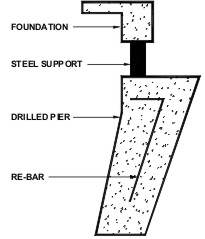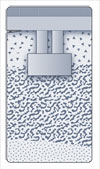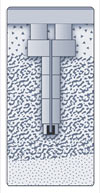Educating the customer, it’s one of our top priorities.
We always want our customers to understand how our methods work, especially when it comes to the foundation of your home. With Louisiana’s unique soil conditions, we’ve taken the time to figure out the right methods that will keep your home standing strong for years to come.

Drilled Pier Method (Our Method)
- Most widely recommended by structural engineers.
- Used in large building construction.
- Extends below active soil depths.
- Not affected by moisture variations, (most common cause of foundation problems.)
- Float resistance due to widened portion at the top of the pier.
- Bearing support at the bottom where the soil is denser and more compressed.
- Angle installation for proper placement under the foundation grade beam.
- Greater friction between the pier and surrounding soil.
Spread Footing Method (Not Recommended)

- Concrete pad approximately 2′ square by 1′ thick.
- Only extends to a depth of 2′ to 3′.
- Not below active soil nor resistant to moisture variations.
- Considered to be a temporary solution by
- engineering standards.
- Less effective than drilled piers
Driven Pier (Not Recommended)

- Steel pipe or concrete segments driven into the ground against the weight of the structure.
- No way of verifying that the pipe or concrete segments are straight.
- In dry, hard soil conditions these piers cannot be driven to adequate depths before the structure begins to rise.
- Very expensive. $$$
- Much smaller piers, have no conical friction capacity.